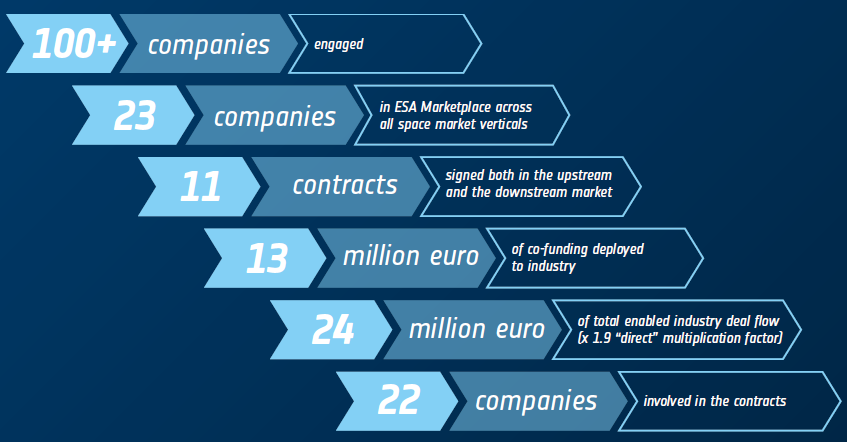The Zero Debris Community brings together a broad range of space actors—start-ups, research centres, major companies, and public institutions—mobilised around one ambitious goal: achieving Zero Debris by 2030.
As the space sector rapidly expands, so too does the urgency to safeguard its long-term sustainability. With thousands of satellites already in orbit—and many more launched each year—space debris has become a critical threat to the future of space-based infrastructure and services.
In this context, the second Zero Debris Webinar, held under the theme “Unlocking Funding for Zero Debris Innovation & Commercialisation”, explored how concrete funding mechanisms and partnerships can help transform promising ideas into real-world, market-ready solutions.
Driving Commercialisation Through ESA Space Safety Programme’s Competitiveness Segment
The ESA’s Space Safety Programme (S2P), launched in 2019, aims to protect both space and Earth from hazards such as debris, space weather, and near-Earth objects. For the “clean and zero debris” domain, ESA is focused on developing technologies for further enhancing the safety and sustainability of European space activities, demonstrating technologies in preparation of a Zero Debris approach and a circular economy in space, and enhancing capabilities to assess environmental impacts on Earth.
During the webinar, Tim Flohrer, Head of the Space Debris Office at ESA, underscored achieving sustainability in space is not only essential for maintaining our access to space services, but also critical for ensuring the long-term competitiveness of the European space industry.
The Competitiveness Segment
One of ESA’s flagship tools is the Competitiveness segment, which support the last mile efforts in developing a product or a service for the space safety market. It targets companies with technologies at TRL 6 or above, ready for advanced development and demonstration.

Through this, ESA acts as a “partner” in the meaning of ESA Commercialisation Policy, i.e. as a trial user and early adopter of the industry’s products or services to reduce business risks.
The agency offers co-funding—up to 80% for SMEs—and provides access to ESA expertise, technical validation, and real operational data.
Who can apply?
- Companies from participating in S2P’s Competitiveness segment countries (Austria, Denmark, Germany, Greece, Hungary, Italy, Norway, Poland, Portugal, Slovakia, Canada).
- Applicants must demonstrate strong technical and managerial credibility, a solid business model, and the readiness to co-fund the activity.
Call for Proposal Process
The two-steps process is built to be agile. After companies submit an outline proposal, it is reviewed and iterated with ESA experts. Once approved, and if backed by national delegations, a full proposal is requested and can be directly negotiated. This ensures both maturity and speed. On average, the time from proposal to contract is just five months.

Implementation status
So far, the results have been promising, as 16 outline proposals have been submitted, 15 were positively evaluated, and 10 projects have already kicked off, with more expected to begin before the summer of 2025. Given the positive response, ESA plans to scale up and refine this tool at the upcoming Council Meeting at Ministerial Level (CM25).
EIC Funding Instruments for a Zero Debris Future
Alongside ESA’s tools, the European Innovation Council (EIC) offers powerful funding instruments to support breakthrough technologies in the space domain. As explained by Stella Tkatchova, EIC Programme Manager for Space Systems and Technologies, the EIC funds innovations from early research through to market scale-up, thanks to top-down and bottom-up funding streams.
The EIC space portfolio includes space debris sustainability (e.g. removal, monitoring, in-orbit servicing), space technologies (e.g. propulsion, in-space manufacturing) and Earth observation and meteorology.
EIC Programmes

The Pathfinder programme offers grants of up to €4 million for low-TRL projects (TRL 1 – 4), targeting mainly consortia. The Transition programme supports small consortia and single applicants (SMEs, spin-offs, start-ups, research organisations, universities) developing business cases and maturing technologies, providing grants of up €2.5 million for mid-stage projects (TRL 4 – 6). Finally, the Accelerator programme targets high-TRL (TRL 6 – 9) technologies from single applicants (Startups and SMEs), often with a combination of grants (up to €2.5 million) and equity investment (up to €10 million) to help companies enter the market and grow rapidly.
Challenge calls
In 2024, the EIC issued a challenge call focused on space sustainability and resilience, including debris removal, in-space recycling, and re-use of orbital assets. Although that call is now closed, companies can still apply through the Pathfinder Open call with similar projects.
The EIC’s 2025 challenge continue in this direction, focusing on Innovative in-space servicing, operations, robotics and technologies for resilient EU space infrastructure, with an indicative budget of €50 million. The start-ups and SMEs to be supported under this initiative must deliver solutions that address one of the following areas: in-orbit servicing & maintenance, in-space transportation or space-based resilience. The deadline is set for October 1, 2025, and eligible applicants must be based in an EU or EU-cooperative state. Applications to the EIC Accelerator challenges must be done on the Funding and Tenders portal.

An EIC’s Success Story: The E.T.PACK Initiative
A shining example of the EIC’s impact is the E.T.PACK initiative, which developed Electrodynamic Tethers (ET)—long conductive tethers that interact with ambient plasma and magnetic field to generate propulsion without propellant. These can be used both to de-orbit and re-boost satellites and can scale with user needs.
As explained by Gonzalo Sanchez Arriaga, the project began in 2019 with an EIC Pathfinder Open grant. It subsequently advanced through a Launchpad grant, which supported the development of a market analysis, and later secured an EIC Transition grant to prepare a flight-ready version of the technology. In 2023, the team founded PERSEI Space, and in 2024 the company joined ESA’s Business Incubation Centre (BIC) programme (see hereafter). Looking ahead, a first in-orbit demonstration of the E.T.PACK device is planned for 2026 under the ESA-EC Flight Ticket Initiative.
ESA Commercialisation Pathways for Advancing Zero Debris
The Commercialisation, Industry and Competitiveness (CIC) Directorate focuses transforming Europe into a global hub for space commercialisation by empowering companies with the tools, funding, and networks they need to succeed.
The CIC’s strategy is built around three pillars:
- Speed – enabling European industry to stay ahead in a fast-moving global market.
- Capital – unlocking the financial resources needed for companies to grow and scale.
- Talent – fostering the expertise required to design and deploy innovative space technologies.
ESA supports companies across the entire scale-up journey—from idea to market—through a comprehensive suite of programmes.
At the early stage, ESA’s Business Incubation Centres (ESA BICs) offer vital support to start-ups. With 32 centres across Europe, more than 230 start-ups are supported each year, and over 1,800 companies have been incubated since the programme began.

As companies move into the pre-commercialisation phase, ESA provides targeted R&D funding programmes to help them advance their technologies and bring them closer to operational readiness. For companies approaching the market with mature technologies, ESA offers commercial acceleration tools like the ESA Marketplace.
Throughout all phases, ESA leverages its investor network—including business angels, venture capitalists, private equity firms, and institutional investors—to attract capital into the European space ecosystem and support companies on their growth trajectory.
ESA Marketplace
For companies with mature products at TRL 7 and above, ESA offers a strategic tool called the ESA Marketplace. Introduced by Kais Barmawi, this programme helps address common challenges like scaling, customer acquisition, and go-to-market strategies.
Rather than supporting technical development, the Marketplace is focused on accelerating commercialisation. ESA can co-fund activities that help companies access new customers or overcome bottlenecks that hinder commercial deployment. For SMEs, funding can cover up to 80 %of eligible costs.
For companies based in Member States that have subscribed to ScaleUp, ESA can co-fund part of the customer acquisition costs—whether the target customers are upstream actors from ScaleUp-subscribing Member States, downstream users from ESA Member States, or clients outside the space sector, including those in non-ESA Member States.
Likewise, to accelerate time to market for companies based in Member States that have subscribed to ScaleUp, ESA provides financial support for strategic purchases that enable sales. This may include acquiring upstream services from suppliers in ScaleUp-subscribing Member States, supply chain elements from ESA Member States, or launch services from providers in non-ESA Member States.
To qualify, companies must be based in the following countries: Belgium, Germany, United Kingdom, Luxembourg, Switzerland, Finland, Austria. They must already be commercially active, have a solid business model and TRL 7+ technology.
The application process begins via the ScaleUp INVEST programme channel on the Open Space Innovation Platform (OSIP). Once selected, the company proposes a business-to-business deal with a commercial partner, reviewed by ESA and national delegates.

An ESA’s Success Story: Vyoma
A prime example of a company benefitting from ESA’s commercialisation pathways is Vyoma, a start-up developing the Flamingo satellite constellation. These satellites will use passive optical systems to monitor the space environment and provide real-time data for satellite operators, helping them avoid collisions and maintain safe orbits.
As emphasised by Stefan Frey, Vyoma’s collaboration with ESA illustrates the value of long-term support in building commercially viable, sustainable space ventures. The company is an alumni of the Hessen ESA BIC, participated in small ESA studies, joined the ScaleUp Invest Marketplace, and benefitted from support for their first satellite launch and the building of their second satellite, through funded partnership with Exolaunch and Aerospacelab. Vyoma is also part of the S2P Competitiveness segment, which helped increase the TRL of one of their key services. More recently, they joined the German ESA Business Accelerator, connecting with other start-ups at a similar stage of growth.
Together Towards a Zero Debris Space
The Zero Debris movement is not only about removing debris – it’s about enabling long-term sustainability in space through shared responsibility and collaboration. A growing ecosystem of innovators, funders, and institutions is already forming around this vision, supported by targeted programmes that are helping turn bold ideas into practical solutions.
While further tools may be needed, the ones already in place offer a strong foundation – and now is the time to make the most of them. For start-ups, researchers, and companies across Europe, this is a pivotal moment to get involved and help collectively achieve the ambitious Zero Debris targets by 2030.

📺 Watch the webinar replay
If you missed the event or would like to revisit the discussions, you can watch the full webinar replay here:

Discussion: no comments